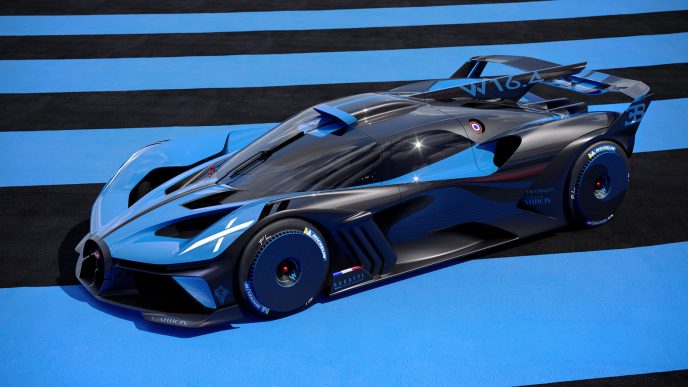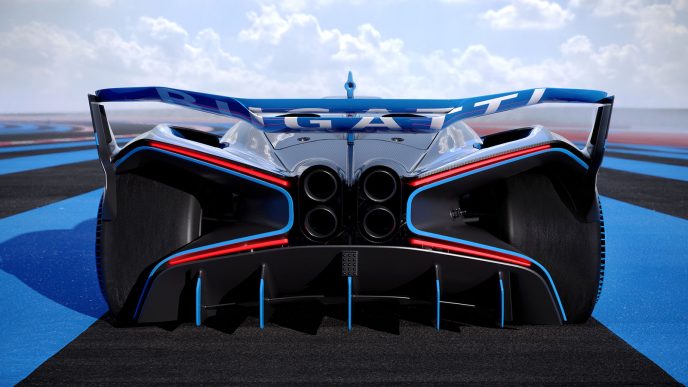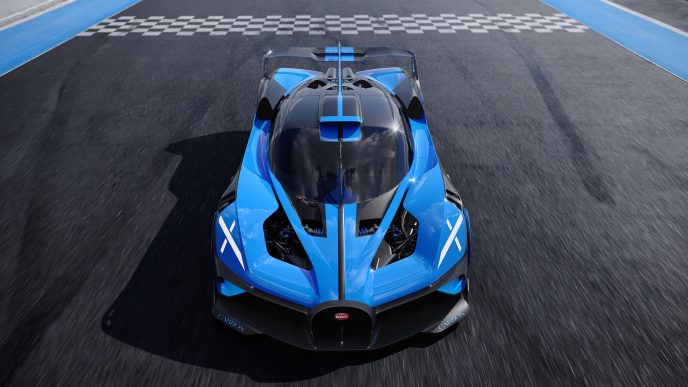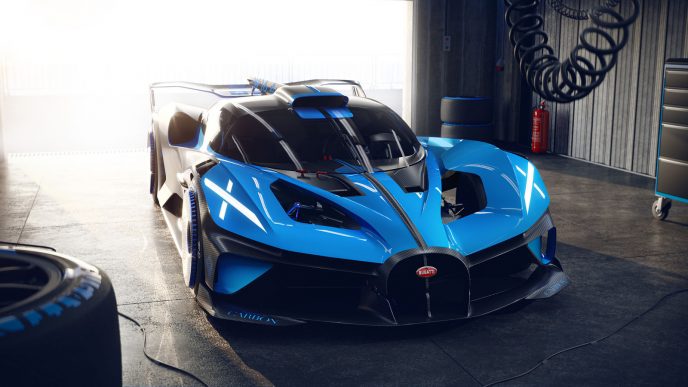Reduced, raw, authentic. With the technological concept of the Bugatti Bolide, the French luxury car manufacturer is now providing the answer to the question, what if Bugatti built a radically light vehicle around its iconic 8.0-litre W16 engine?
The Bolide, which means “a very fast car” in French, is the most extreme, uncompromising, fastest and lightest vehicle concept in the company’s history – with an incredible weight-to-power ratio of 0.67 kg per PS. This is made possible by the combination of the W16 engine with 1,850 PS and a dry vehicle weight of just 1,240 kg. The Bugatti Bolide achieves figures that are almost on par with Formula 1 while its top speed is well above 500 km/h. Bugatti computer simulation claims the Bolide can complete a lap of Le Mans in 3:07.1 and run the famous Nordschleife in only 5:23.1.
We asked ourselves how we could realise the mighty W16 engine as a technical symbol of the brand in its purest form – with solely four wheels, engine, gearbox, steering wheel and, as the only luxury, two seats. Important aspects of our considerations were fine-tuning our iconic powertrain without any limitations as regards the weight-to-power ratio. These considerations resulted in the Bugatti Bolide. An uncompromising experiment, a thoroughbred, a Pur Sang that, in its brute exclusivity, impresses above all with high performance, low weight, and a driving experience in a whole new dimension. Driving the Bolide is like riding on a cannonball.
The 8.0-litre W16-cylinder engine with 1,850 PS and 1,850 newton-metres of torque. Bugatti has designed the drive specifically for use on the racetrack and has optimized the engine and gearbox in particular for higher engine speeds. This includes de-throttling the intake and exhaust system to achieve an even faster, more spontaneous response characteristic. The four newly developed turbochargers are fitted with optimized blades in order to build up more boost pressure and power at higher engine speeds.
Instead of water-to-air intercooling, the Bugatti Bolide has air-to-air intercooling with water pre-cooling for optimal performance on the racetrack. The inflow takes place from the front via one internal and one external air duct on each side of the vehicle. The two water coolers, which are arranged in front of the front axle, provide a more effective radiator system in terms of flow than is customary even in Formula 1. Three air-cooled oil coolers for engine, transmission, and differential with water pre-cooling reduce the temperature even on demanding race laps.
In order to achieve a dry weight of 1,240 kilograms, all the stops have been pulled out with regard to the materials and production processes used.
All the screw and fastening elements of the Bolide are made completely out of titanium. In addition, hollow, thin-walled functional components made of an aerospace titanium alloy are used in many places. These originate from a 3D printer and are extremely thin with wall thicknesses of up to 0.5 millimetres.
A worldwide innovation is the morphable outer skin of the intake scoop on the roof, which provides active airflow optimisation. If the vehicle is driven at a slow speed, the surface of the scoop remains smooth. In contrast, a field of bubbles bulges out when driven at fast speeds. This reduces the aerodynamic drag of the scoop by 10 percent and ensures a 17 percent reduction in lift forces. In addition, the flow onto the rear wing is optimised. At 320 km/h, the downforce is at 1,800 kilograms at the rear wing and 800 kilograms at the front wing.
As in Formula 1, the Bolide decelerates with racing brakes with ceramic discs and coatings. The brake calipers weigh only 2.4 kilograms each. The front forged magnesium rims with central lock weigh 7.4 kilograms, while the ones at the rear weigh 8.4 kilograms – with a very wide tyre size of 340 millimetres on the front axle and 400 millimetres on the rear axle (Chiron: 285 mm at the front and 355 mm at the rear). A compressed-air-driven jack system with four rams makes tyre changing easier, a quick refueling system allows pressure refueling.
With an overall height of only 995 millimetres, the Bugatti Bolide is exactly the same height as the historic Bugatti Type 35, depending on the steering wheel and truncated windscreen, and about 300 millimetres flatter than the Chiron. The wheelbase is 2.75 metres and the width 1.99 metres. Like in an LMP1 racing car, the occupants fold up the doors that are hinged at the front at an angle, sit on a sill that is only 70 millimetres wide, as in a Type 35, and then position their feet in the interior.
Safety is ensured with safety equipment designed in accordance with FIA regulations. These include HANS device compatibility, an automatic fire extinguishing system, a towing device, pressure refueling with fuel bladder, central locks for the wheels, lightweight polycarbonate windows, and a six-point harness system. The driver can see all the relevant data on a motorsport display. For an optimum sitting position, both the pedals and the passenger footrest can be moved by 150 millimetres.
Whether the Bugatti Bolide will go into series production, has not been decided yet.





